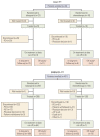Talazoparib Versus Chemotherapy in Patients with HER2-negative Advanced Breast Cancer and a Germline BRCA1/2 Mutation Enrolled in Asian Countries: Exploratory Subgroup Analysis of the Phase III EMBRACA Trial
- PMID: 33781053
- PMCID: PMC8524025
- DOI: 10.4143/crt.2020.1381
Talazoparib Versus Chemotherapy in Patients with HER2-negative Advanced Breast Cancer and a Germline BRCA1/2 Mutation Enrolled in Asian Countries: Exploratory Subgroup Analysis of the Phase III EMBRACA Trial
Abstract
Purpose: We evaluated study outcomes in patients enrolled in Asian regions in the phase III EMBRACA trial of talazoparib vs. chemotherapy.
Materials and methods: Patients with human epidermal growth factor receptor 2-negative germline BRCA1/2-mutated advanced breast cancer who received prior chemotherapy were randomized 2:1 to talazoparib 1 mg/day or chemotherapy (physician's choice). Primary endpoint was progression-free survival (PFS) per independent central review in the intent-to-treat (ITT) population. This post-hoc analysis evaluated efficacy/safety endpoints in the ITT population of patients enrolled in Asian regions.
Results: Thirty-three patients were enrolled at Asian sites (talazoparib, n=23; chemotherapy, n=10). Baseline characteristics were generally comparable with the overall EMBRACA population. In Asian patients, median PFS was 9.0 months (95% confidence interval [CI], 3.0 to 15.2) for talazoparib and 7.1 months (95% CI, 1.2 to not reached) for chemotherapy (hazard ratio [HR], 0.74 [95% CI, 0.22 to 2.44]). Objective response rate was numerically higher for talazoparib vs. chemotherapy (62.5% [95% CI, 35.4 to 84.8] vs. 25.0% [95% CI, 3.2 to 65.1]). Median overall survival was 20.7 months (95% CI, 9.4 to 40.1) versus 21.2 months (95% CI, 2.7 to 35.0) (HR, 1.41 [95% CI, 0.49 to 4.05]). In Asian patients, fewer grade 3/4 adverse events (AEs), serious AEs (SAEs), grade 3/4 SAEs, and AEs resulting in dose reduction/discontinuation occurred with talazoparib than chemotherapy; for talazoparib, the frequency of these events was lower in Asian patients versus overall EMBRACA population.
Conclusion: In this subgroup analysis, talazoparib numerically improved efficacy versus chemotherapy and was generally well tolerated in Asian patients, with fewer grade 3/4 treatment-emergent AE (TEAEs), SAEs, and TEAEs leading to dose modification vs. the overall EMBRACA population.
Keywords: Asian; BRCA1/2 mutation; Breast neoplasms; HER2-negative; PARP inhibitor; Phase III; Talazoparib.
Conflict of interest statement
Kyung-Hun Lee reports honoraria from Roche and AstraZeneca, and has participated in advisory boards for Bayer, Ono Pharmaceutical, Samsung Bioepis, Roche, Eisai, and AstraZeneca.
Sung-Bae Kim reports research funding from Novartis, Sanofi-Aventis, and DongKook Pharm Co., and has participated as a consultant in advisory boards for Novartis, AstraZeneca, Lilly, Dae Hwa Pharmaceutical Co. Ltd, ISU Abxis, and Daiichi-Sankyo.
Joohyuk Sohn reports research grant/funding from MSD, Roche, Novartis, AstraZeneca, Lilly, Pfizer, Bayer, GSK, CONTESSA, and Daiichi-Sankyo.
Annabel Goodwin reports honoraria from AstraZeneca and Pfizer for participation in advisory boards.
Tiziana Usari and Silvana Lanzalone are employees of Pfizer.
Seock-Ah Im reports research funding from AstraZeneca, Eisai, Roche, Pfizer, and Daewoong Pharm Co., and has participated as a consultant in advisory boards for AstraZeneca, Amgen, Hanmi, Eisai, GSK, Idience, Lilly, MSD, Novartis, Daiichi-Sankyo, Roche, and Pfizer.
Figures


References
-
- Ashworth A. A synthetic lethal therapeutic approach: poly (ADP) ribose polymerase inhibitors for the treatment of cancers deficient in DNA double-strand break repair. J Clin Oncol. 2008;26:3785–90. - PubMed
Publication types
MeSH terms
Substances
Grants and funding
LinkOut - more resources
Full Text Sources
Other Literature Sources
Medical
Research Materials
Miscellaneous

